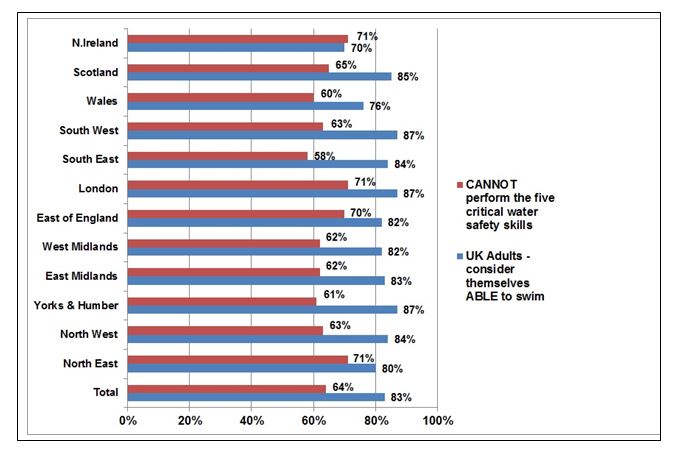More Than Half of UK Swimmers Come Up Short in Water Lifesaving Skills Test
As the latest UK drowning statistics for 2013 are published*, STA has undertaken a survey to understand how competent British adults, who claim they can swim, are in the water.
2/3 UK adults cannot perform the five critical water safety skills needed that could save their lives
Four in five (83%) British adults consider themselves as being able to swim. However, two-thirds (64%) cannot perform the five critical water-safety skills needed that could save their lives, according to a new survey by STA.
Competency with all five – floating or treading water for one minute without a flotation device; entering the water safely and being able to turn around and return to a point of safety; rotating from your front to your back; exiting a pool without using a ladder; swimming 25 meters (the length of a standard pool) without stopping – is essential to being able to help yourself in a pool or open-water environment advises Dave Candler, STA President.
With July and August being the peak months for drowning fatalities, STA, the world’s largest swimming teaching and lifesaving organisation, is urging people to be careful and water smart this year.
“Tragically last year we saw a high number of drownings in the UK and more needs to be done to educate children, teenagers and adults about water safety and the dangers of swimming in open water,” said Mr Candler. “People, who have convinced themselves that because they can swim they can do more in the water than they’re capable of, run the risk of endangering themselves or others. And, as this survey has proved, two thirds of people who say they can swim cannot perform critical water safety skills.”
Surprisingly many of the people who tragically drown can actually swim, or think they can, and as such are overly confident in and around the water.
Its also interesting that of those surveyed, males aged 18-34 scored the highest; 88% consider themselves as being able to swim, yet the latest 2013 drowning statistics published by WAID*, show that the highest number of fatalities was amongst males aged between 20-34 – of the 88% males aged 18-34 surveyed by STA, more than half (55%) cannot perform all five critical water-safety skills.
STA say it’s not just a case of learning to swim, as even the strongest swimmers can struggle in open water, it’s about people understanding the potential dangers that lurk beneath the surface. Swimming teachers, school teachers, parents must all ensure that everyone knows how to stay safe in and around water.
Interestingly the research also found that the relative majority (38%) of British adults think that a person must be able to swim a minimum distance of 25 metres in a swimming pool unaided, and without stopping, before considering that person as being able to swim. One in five (21%) consider the minimum distance to be 10 metres. Mr Candler confirmed that these statistics are very worrying.
“Being able to swim 25 (or even 100) metres in a warm pool in a swimming costume does not make a person safe. If a person falls into cold water, the cold, the current and the clothes will reduce the distance capacity by a huge percentage. The cold water can also result in the body going into shock – just one gulp of cold water is all it can take.
People can also become entangled in hidden debris and reeds. There may also be underwater currents that can drag the body under, and the depth of the water cannot be estimated either – it may seem shallow, but in open water there can be pockets of deep water that are not clearly visible from the water’s edge. All these factors can result in someone getting tired quickly and drowning.”
“During the holidays, we want everyone to enjoy activities in and around the water, but we want them to understand the risk, and do it safely and in supervised surroundings,” concluded Mr Candler.
* The latest drowning figures published by the National Water Safety Forum (NWSF) in July 2014, show there were a total of 381 drownings and water-related deaths from accidents or natural causes across the UK in 2013. As in previous years, more than half of the deaths (227) in 2013 were in inland waters, such as tidal and freshwater rivers, lakes and reservoirs, while fatalities at the sea, on the beach or shoreline accounted for nearly a third (115).
The NWSF’s Water Incident Database (WAID) breaks down drownings and other water-related deaths by activity, age and location type. It reveals that in 2013, the highest number of fatalities (31) was males aged between 20-24. Meanwhile, 0-19s accounted for 12 per cent of deaths (46), of which more than half were teenagers aged 15 to 19 (27). In the youngest age bracket of four and under, 10 children drowned.
The peak summer months of July and August witnessed the most deaths with 106 during this period. A full copy of the UK Water-related Fatalities 2013 report can be viewed here.
This independent online survey was comissioned by STA in July 2014 with 2,006 UK adults aged 18+. More information here on how each UK region scored in STA’s water lifesaving skills test.

- Categories
- Water Safety, Health & Wellbeing


